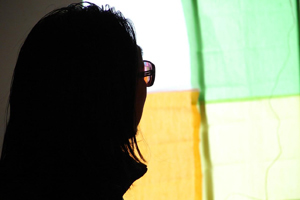At DOVA workshop, Tiravanija shares his artistic vision: ‘Art is made from life’
By Josh SchonwaldNews Office
 Photo of Rirkrit Tiravanija courtesy of Kimmy Noonen |
|
Knowing the work of contemporary artist Rirkrit Tiravanija often means having no expectations about what he will create next.
At a recent visiting artist workshop at Midway Studios, sponsored by the Open Practice Committee, 10 graduate students in the Department of Visual Arts shared pizza, conversation and a campfire with Tiravanija, whose work has been exhibited in solo shows at leading museums across the globe.
The 2004 recipient of the contemporary art world’s most prestigious honor, the Hugo Boss Prize, Tiravanija has exhibited in the Museum of Modern Art in New York, Basel’s Kunsthalle and the Los Angeles County Museum. He also has co-curated shows at the Venice Biennale. In short, Tiravanija is a superstar.
Chicago graduate student Manol Georgieff was especially excited to be at the workshop, but conceded, he had no idea what to expect.
Tiravanija—who, with his long black hair, cargo pants and aviator-style glasses, looked like he could play bass for a heavy metal band (he does have a band)—arrived shortly after noon at Midway Studios. He then gathered the group of students in Midway’s sculpture room, including 10 students from the School of the Art Institute who had come down for the workshop. Then, he instructed them to rearrange some sofas—five Chicago students were paired with five Art Institute students.
Then the workshop began.
Students sat in their small groups, ate pizza, drank coffee, chatted. At 2 p.m., this continued. At 3 p.m., this continued. After three hours had passed, a student who was commissioned to videotape the workshop was perplexed. Nothing has happened, he said. This is it.
About 3:30 p.m., the workshop moved out of the sculpture room, into the Midway Studios courtyard, where the 20 students and Tiravanija started a campfire, broke out some marshmallows and made S’mores. Their eating and conversation continued.
 Image courtesy of Chicago Media Initiatives Group | |
Asked about the goals of the workshop, the artist smiled wryly and explained, “This is it. This demonstrates the type of work that I do.” The pizza and the fire, he said, are the central events. “It’s about creating a social space, being a catalyst for conversation,” he explained.
The Chicago students were experiencing precisely the type of art that has made Tiravanija famous. He is known as a creator, or perhaps facilitator, of social events in which art and life cross paths.
In 1992, he transformed a New York gallery into a restaurant, where he prepared and served free Thai meals daily. In 1995, for the Whitney Biennial, he built an empty room-size structure—it was meant to be used as a practice space for rock bands, including his own. In another gallery show, he created a replica of his apartment and had students live in it. He would stop by occasionally to cook meals.
The artist, who is known for his itinerant existence but is currently based in Thailand, felt the visit to Midway Studios was successful. “It’s not about what’s good or bad,” he said, “It’s better when everyone talks. It’s better when someone talks to someone they don’t know, from another place. It’s better when there’s movement around the space.”
Though the event was aimed at bringing art students together, Tiravanija said he was not trying to direct the content of the conversations. “If you bring artists together, they’ll talk about art,” he said. “That’s a given. They’ll talk about their different institutions, their own work.” He had conversations with students about art, but he also counted several other conversations—one about pizza from upstate New York, another about S’mores. These non-art conversations are equally relevant, he said. “Art is made from life.”
Tiravanija did have one mild regret about the Chicago visit. He had visited Midway Studios years ago and remembered its fireplaces. The fireplaces, he said, would have been ideal for framing a social space. Due to city fire code, this was impossible. “That’s why we had to go outside,” he said.
But one achievement of his visit: it sparked a conversation about the long-dormant fireplaces. “We have negotiated it,” he said, proudly. “There is now a plan to try and clean up the fireplaces.”
![[Chronicle]](/images/sidebar_header_oct06.gif)